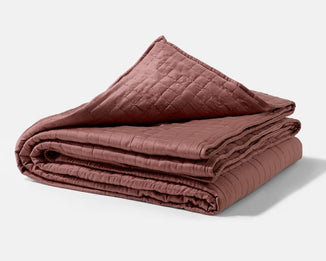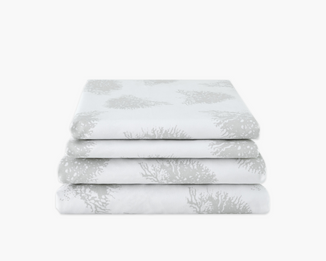
Jul 27, 2023
Weighted Blankets for Autism: 7 Benefits

The unique sensory experiences and processing challenges commonly associated with autism often call for innovative, individualized solutions to enhance comfort, well-being and daily functioning. Enter weighted blankets, a therapeutic tool showing promise in scientific research, thanks to their ability to provide calming, deep-pressure stimulation that can alleviate anxiety, promote relaxation and aid in sensory integration. We invite you to join us on this informative journey to discover how weighted blankets can make a meaningful difference in the lives of those with autism.
Understanding Autism Spectrum Disorder and Common Co-Occurring Conditions
Autism spectrum disorder (ASD) is a complex neurodevelopmental condition characterized by a range of symptoms and behaviors. These can include difficulties with social interaction and communication, repetitive behaviors and unique patterns of interest or activities. Each person with autism is different, reflecting a “spectrum” of characteristics and experiences that can vary widely from individual to individual. ASD also affects sensory processing, where individuals may be hypersensitive or hyposensitive to certain sensory stimuli, which can be overwhelming or confusing.

In addition to the core symptoms of ASD, it’s not uncommon for individuals with autism to experience other co-occurring conditions. One such condition frequently observed is sensory integration dysfunction (SID), where the brain struggles to correctly organize and interpret sensory information. This can cause a variety of challenges, from over-responsiveness to certain sensory inputs, such as loud noises or bright lights, to under-responsiveness, where more intense sensory stimuli are needed for the person to react.
These co-occurring conditions can significantly impact the lives of individuals with autism, affecting their daily routines, learning capabilities and social interactions. Sensory experiences, an integral part of our daily lives, can be intense and distressing for a person with autism. This underscores the importance of sensory integration theory, which attempts to explain how we perceive and respond to sensory information and how this process can be disrupted in conditions like autism.
Find the Perfect Weighted BlanketAn Overview of Sensory Integration Theory
Sensory integration theory, originally proposed by occupational therapist and psychologist A. Jean Ayres, explains how our brains process sensory information from the environment and our bodies to produce adaptive responses. This neurobiological process is needed for learning, motor skills and behavior. For individuals with ASD, sensory integration can present challenges. In cases of sensory integration dysfunction, the individual might struggle to filter, interpret or respond appropriately to sensory information, which can affect multiple sensory systems such as auditory, tactile and visual.
This theory has substantial implications for understanding behaviors and learning capacities in ASD. If sensory information is not integrated correctly, it may lead to sensory-based behaviors, like hand-flapping, rocking or avoidance of certain stimuli. Therapeutic interventions based on sensory integration theory, including occupational therapy and tools like the weighted blanket, aim to support individuals in processing sensory information more effectively and managing potential overstimulation or under-responsiveness.

Sensory Integration Dysfunction in Individuals with Autism
Sensory integration dysfunction is commonly observed in individuals with ASD. This can manifest in sensory-based behaviors, such as seeking or avoiding certain sensory inputs. For instance, an individual might be hypersensitive (over-responsive) to sound and become distressed by noises that others might easily ignore. On the other hand, they might be hyposensitive (under-responsive) and not react to sensory stimuli that others find overwhelming, potentially leading them to seek intense sensory experiences.
These sensory processing anomalies can considerably impact the daily lives of people with ASD, affecting their capacity to engage in social interactions, concentrate in school or partake in activities of daily living. However, there is hope in managing SID through approaches like occupational therapy. This therapeutic intervention aids individuals with autism in improving their sensory processing, promoting functional performance and enhancing their quality of life. The potential role of weighted blankets in such therapeutic regimens is one such advance and something we’ll dive deeper into.
The Role of Sensory Integration Theory in Occupational Therapy
Occupational therapists harness the principles of sensory integration theory to devise tailored strategies that help individuals with autism manage their unique sensory challenges. The interventions may range from sensory-based activities — like swinging or deep pressure activities — to controlled exposure to certain stimuli, all conducted within a safe, supportive environment. The goal is to facilitate more adaptive responses to sensory stimuli, improving the person’s overall functioning and participation in everyday activities.
The role of occupational therapists extends beyond direct interventions. They also collaborate with other professionals — such as teachers, psychologists and family members — to ensure comprehensive support for the individual. Moreover, occupational therapists may introduce therapeutic tools to supplement their strategies. One such tool, the weighted blanket, can be an integral part of sensory-based interventions, offering deep pressure stimulation, which can be calming for individuals with autism.
The Science Behind Deep Pressure Stimulation
Deep pressure stimulation (DPS) is a technique that involves applying gentle, sustained pressure to the body. This sensory input can be likened to a firm hug, swaddling or being under a weighted blanket. DPS works by engaging the body’s proprioceptive sense, our sense of body awareness, helping individuals better understand their body’s position in space. As such, DPS can promote feelings of calm, security and grounding, particularly among individuals with ASD.
Physiologically, DPS has been shown to significantly impact the body’s function. It stimulates the parasympathetic nervous system — the part of the autonomic nervous system that helps the body rest and digest. This can reduce heart rate and cortisol levels, the body’s main stress hormone. Consequently, DPS can alleviate anxiety and foster relaxation, which is particularly beneficial for individuals with ASD who often experience heightened anxiety. However, the effectiveness of DPS can vary among individuals, and its full potential is still under research.
The relevance of DPS in the context of ASD is rooted in the sensory processing anomalies common in this condition. As we’ve noted, people with ASD often exhibit hypersensitivity or hyposensitivity to various sensory stimuli. By offering a consistent, calming sensory experience — like that provided by a weighted blanket — DPS may help manage these sensory irregularities. The calming effects of DPS can complement the sensory integration strategies used in occupational therapy, contributing to the improved daily functioning of individuals with ASD.

Benefits of Using Weighted Blankets for Individuals with Autism
Weighted blankets have emerged as an effective tool for enhancing the lives of individuals with autism spectrum disorder. These blankets offer consistent and soothing deep-pressure stimulation as a conduit for relaxation, comfort and improved sensory processing. We’ve compiled seven major benefits of using weighted blankets for individuals with ASD, ranging from improved sleep quality to providing a non-pharmacological intervention strategy.
1) Improved Sleep Quality
With deep pressure stimulation, weighted blankets can contribute to more restful sleep for individuals with ASD. By providing a feeling of comfort and relaxation, weighted blankets have the potential to alleviate some sleep-related challenges common in ASD. This not only promotes a better sleep pattern but also aids in overall health, recognizing the fact that quality sleep is a cornerstone of well-being.
2) Reduced Anxiety
Weighted blankets are designed to mimic the feeling of a comforting hug. The gentle, constant pressure these blankets provide can help mitigate anxiety, often heightened in individuals with ASD. By fostering a sense of calm, these blankets can induce beneficial physiological changes, such as reduced heart rate and cortisol levels, thereby assisting in anxiety management.
3) Enhanced Focus
The sensory input provided by weighted blankets can help individuals with ASD feel more grounded, thus promoting improved focus and attention. By creating a constant sensory experience, these blankets can help mitigate some of the focus-related challenges common in ASD, enabling better engagement with tasks and activities.
4) Supports Sensory Integration
Weighted blankets align with the principles of sensory integration theory, assisting individuals with ASD in better processing sensory information. As we’ve established, SID is common for those with ASD, so the sensory stimulation provided by these blankets can be an effective tool for managing this issue, thereby enhancing sensory perception and response.

5) Encourages Relaxation
Deep pressure stimulation from weighted blankets can foster a sense of security and comfort, creating a relaxing environment. This can benefit individuals with ASD, including improved mood and reduced anxiety. Additionally, relaxation facilitated by weighted blankets can contribute to a higher quality of life for individuals with ASD.
6) Facilitates Routine Activities
Using a weighted blanket can positively influence daily routines for individuals with ASD, such as transitioning to sleep or waking up in the morning. By aiding in establishing a routine, these blankets can contribute to self-regulation strategies, an essential aspect of ASD management.
7) Provides a Non-Medicinal Intervention
Weighted blankets provide a non-pharmacological method to manage sensory issues experienced by individuals with ASD. Given the potential side effects of medication, some families or individuals may prefer this non-medicinal intervention. Weighted blankets can also be integrated into a comprehensive care plan, playing a role in a holistic approach to ASD management.
How to Choose the Right Weighted Blanket
Choosing the right weighted blanket is an important step in maximizing its potential benefits, especially for individuals with autism spectrum disorder. One of the main aspects to consider is the weight of the blanket. Generally, it’s recommended that the weight of the blanket be approximately 10 percent of the user’s body weight. This guideline ensures the blanket provides adequate deep-pressure stimulation without causing discomfort or posing safety risks. However, individual preferences may vary — some might prefer slightly heavier or lighter blankets. When possible, it’s essential to try different weights to determine what feels most comfortable and effective.
The material of the weighted blanket is another factor to consider. Weighted blankets come in various materials, including cotton, fleece and more. Each material has its own texture and thermal properties, making them more or less suitable depending on the individual’s sensory preferences and potential allergies. For example, a person who tends to feel hot may prefer a breathable cotton blanket, while someone who prefers a soft touch might opt for a fleece blanket. There are also cooling weighted blankets with removable covers that can be changed according to weather or preference, adding a layer of versatility.

When choosing a weighted blanket, the size and weight distribution are as important as the material. The blanket should be large enough to cover the user comfortably but not so large that it hangs off the bed, which can pull the blanket off the user. The weight should be evenly distributed across the blanket to ensure consistent deep-pressure stimulation. High-quality weighted blankets, like those made by us here at Gravity Blankets, will have this feature. Also, consideration should be given to the blanket’s thermal comfort, durability and maintenance. For instance, a cooling weighted blanket might be preferred if overheating is a concern. As with all therapeutic tools, it is always advisable to consult with professionals, such as occupational therapists or physicians, before introducing a weighted blanket — especially for children with autism.
Additional Considerations in the Use of Weighted Blankets
While weighted blankets have shown promising benefits for many individuals with autism, it’s important to understand that the response can differ significantly based on personal characteristics and sensory preferences. In certain cases, the deep pressure stimulation a weighted blanket provides can inadvertently lead to overstimulation. This can result in discomfort or increased anxiety, the opposite of the intended calming effect. Furthermore, some individuals may have physical limitations or sensory preferences that make using a weighted blanket challenging. For instance, those with claustrophobia might find the added weight uncomfortable. At the same time, those with certain physical disabilities might have difficulty moving under the weight of the blanket. Therefore, it is recommended to introduce the weighted blanket gradually and monitor the individual’s response closely. Never leave someone with physical disabilities alone while using a weighted blanket for the first time.
Consulting with a qualified professional can significantly help address these potential issues and help make an informed decision about using a weighted blanket. Occupational therapists, who have a deep understanding of sensory integration theory and the unique sensory needs of individuals with autism, can provide valuable guidance in selecting the right weighted blanket or finding an alternative, such as a weighted robe. They will also assist in developing a customized strategy for introducing the blanket and adjusting its use based on the individual’s response. Physicians and other healthcare professionals can provide important medical insight, especially for individuals with co-existing health conditions. Ultimately, using a weighted blanket should be a part of a comprehensive care plan for managing autism, and professional consultation ensures its use is safe, effective and tailored to the individual’s unique needs.

Wrapping Up in Comfort and Calm
Weighted blankets are an encouraging avenue in the field of autism care, offering a host of potential benefits, from improved sleep quality to enhanced focus. Their comforting embrace is more than a simple physical sensation — it’s a testament to the power of personalized, sensory-based interventions. Let’s not forget, however, the importance of consulting with qualified professionals to ensure that using weighted blankets is part of a well-rounded, individualized care plan.
We hope this guide encourages you to consider weighted blankets for individuals with autism in your life and remember to explore the options available at Gravity Blankets to find the right fit.
Your use of this website, its content, and any products obtained through this website is at your own risk. This website, its content, and any products obtained through this website are provided on an “as is” basis, without any warranties of any kind, either express or implied, including warranties of merchantability, infringement of intellectual property, or fitness for any particular purposes. No warranty or representation is made with respect to the completeness, reliability, quality, or accuracy of this website or its content. This website, its content, and any products obtained through this website do not constitute medical treatment and is not a substitute for a medical examination or diagnosis. If you are dealing with a health condition check with your health care provider before using. This website may contain affiliate links that allow us to earn a commission on purchases made through such links. We may accept forms of advertising or sponsorships in connection with this website. There might also be paid topic insertions. We may accept and keep free products, services, and other forms of compensation from others.
Image Credits
NotionPic/Shutterstock.com
Roman Samborskyi/Shutterstock.com
Marina Shevchenko/Shutterstock.com
Dmitrieva Lidiya/Shutterstock.com
BrazilPhoto/Shutterstock.com
vetre/Shutterstock.com
chekart/Shutterstock.com











